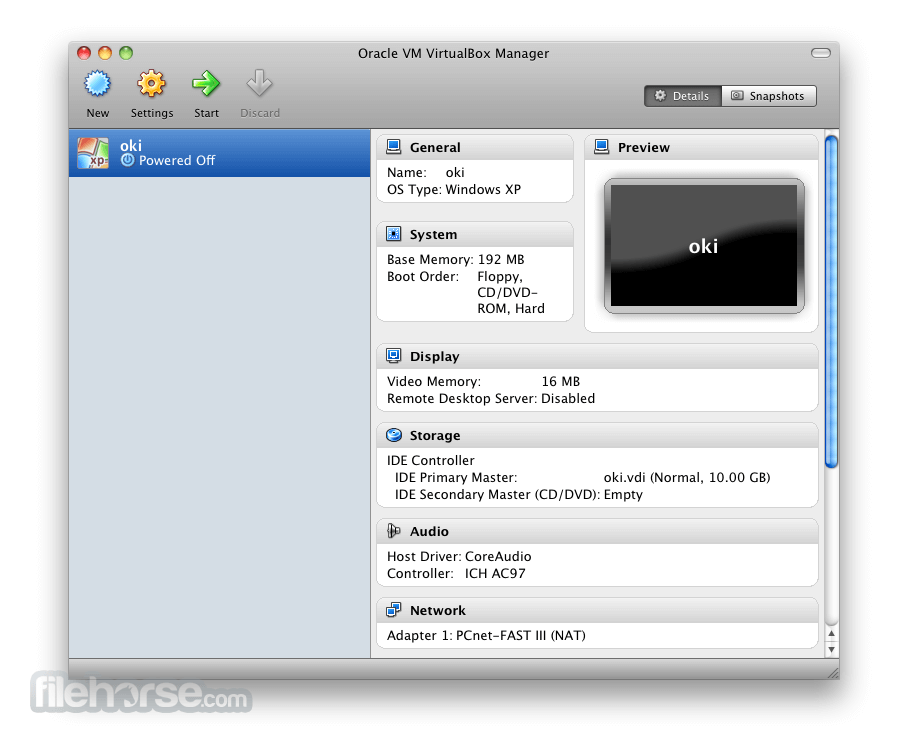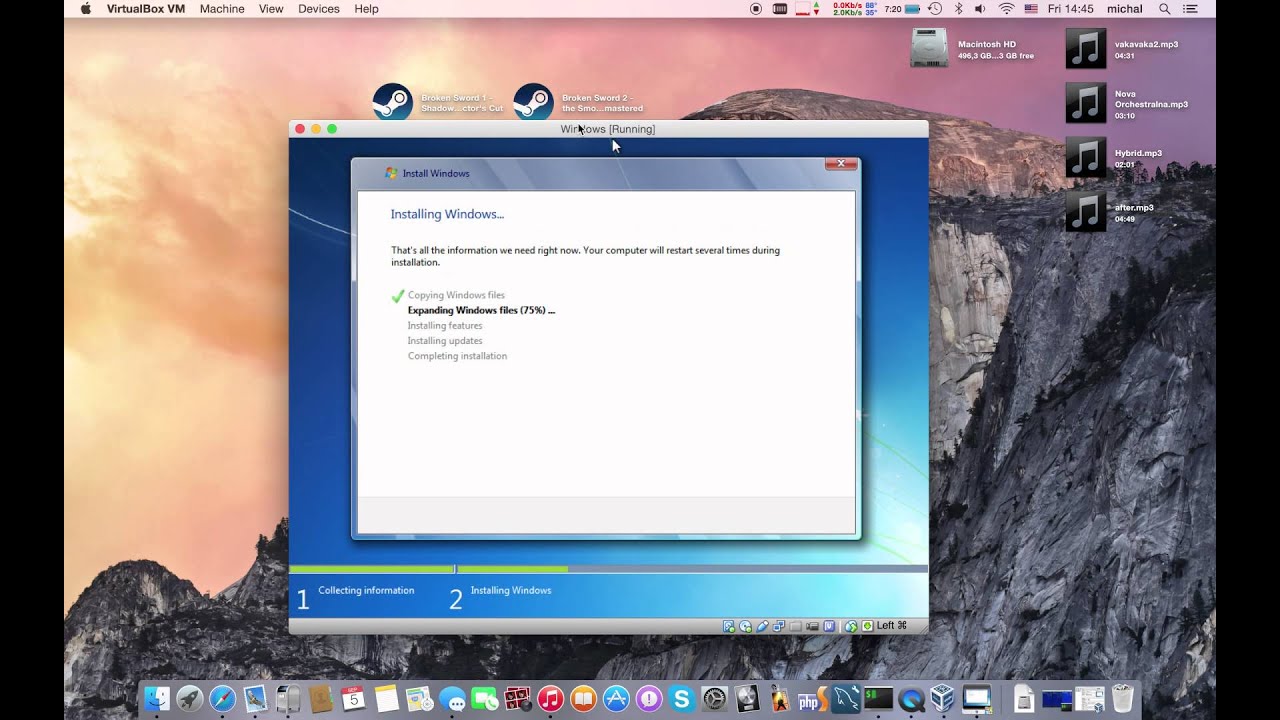Virtualbox On Macbook
- Virtualbox On Macbook
- How To Download Virtualbox On Macbook Pro
- Install Virtualbox On Macbook Air
- Install Virtualbox On Macbook
- Install Virtualbox On Macbook
I never installed virtual box or even ran a virtual machine. Now my computer is unable to install new windows update due to having virtual box on my computer. I'm also unable to locate the uninstaller for it. In the task manager I have a tab for ethernet and it has the subtext Virtualbox host-only ethernet adapter. Programs such as Parallels Desktop, VMWare Fusion and VirtualBox allow you to create a virtual machine (VM), that runs on your Mac just like any other Mac app. The virtual machine uses software to.
If you’re a Mac user, there’s no need to sell your Mac and get a Windows computer. You can use VirtualBox, Parallels or VMWare (links lead to academic versions) to run Windows on your Mac. This tutorial was written for VirtualBox, since it’s free and you don’t have to reboot your computer to access Windows (this is why I don’t recommend Bootcamp, since you lose access to your Mac files and software).
Before you do anything else, make sure your Mac is updated to the latest version of OS X your computer supports, and verify it has 8GB or more of RAM.
Virtualbox On Macbook
1) Download Windows 10
How To Download Virtualbox On Macbook Pro
You can now download an ISO of the installation disk directly from Microsoft. Most likely, you need the 64-bit version. The file you download will be over 3GB, so get this started and move on!
2) Purchase a Windows License
You will need to purchase a Windows 10 Home (64-bit) license, which is available new on Amazon (search for “Microsoft Windows 10 Home 64 Bit OEM”) or a second-hand license available on eBay. What you really need is the activation key, since DVD drives are very uncommon these days.
Install Virtualbox On Macbook Air
Please note that you can install Windows without a license key, but you’ll get a nasty reminder if you don’t activate after a few weeks.
3) Download and Install VirtualBox
Save the DMG to a location on your computer where you will be able to find it (Downloads, Desktop, etc.). If you are on a Mac, you need the version for “OS X hosts.” VirtualBox must be installed before it can be used. When you mount the DMG, you must then run the VirtualBox installer, which will place VirtualBox into your Applications folder.

4) Create your Virtual Machine (VM)
- When you run VirtualBox for the first time, there will be no virtual machines (VMs) installed.
- Click New in the toolbar, which will launch the New Virtual Machine Wizard.
- Give your VM a name such as “Windows 10”.
- Select “Windows” as the operating system, and “Windows 10 (64 bit)” as the version.
- Go with the recommended memory (2048 MB, or 2 GB).
- Leave the default “Create a virtual hard disk now” selected.
- Choose “Create.”
- Next you must configure the hard disk for your VM to use. The default settings should be fine (the drive is dynamic, so will only use the least amount of space on your host computer). Choose “Create.”
- You will now be taken back to the Virtual Machine Manager, which will no longer be empty. You should see the VM you created, and it should be “Powered Off”. Your VM is a computer within a computer, which means it must be started and shut down like a normal computer (it also means it can get viruses so be careful).
5) Install Windows

- Select the new VM you created and choose Settings (gear icon).
- Scroll down to the “Storage” section
- Select “[Optical Drive] Empty” and choose “Choose/Create a disk image…” A dialog will open.
- Choose “Add,” select the ISO you download earlier, and select “Choose”
- Click the green “Start” arrow to start your VM.
You may see a warning that “Auto capture keyboard” is turned on. What is important to note on this screen is the host key, which is set to Left Command key. Use this key to “release” the mouse and keyboard from the VM to switch back to your Mac. You will need to do this if your mouse and keyboard appear to be “stuck” in the VM, meaning you can’t move the mouse out of the VM. Normally after Windows installed, you can simply move your mouse out of the VM window and it will be back on your Mac side. - Your VM should start for the first time. It will boot like a normal computer, but in a window on your Mac. You may get the Virtual Machine host key warning again, select “Do not show this message again” and then “Capture”. You must remember your host key, which defaults to the left Command key.
- Now you’re in the Windows installer. Follow the on-screen instructions, the default settings should be fine. One screen that is a little confusing is the “Upgrade” or “Custom” installation. Since this is a new VM, there is nothing to upgrade, so Custom would be the most logical choice.
Your VM may reboot a few times as Windows in installed, but most of your time will be spent watching your screen, so this would be a good time to get up and walk around.
6) Configure a Shared Folder

Before you can actually use your new VM, you will need to enable a shared folder. This folder is used to access files on your Mac from your VM. If you don’t have a shared folder, then your VM will be landlocked, meaning you won’t be able to get files on or off (you could theoretically use a USB key). To configure a shared folder, your VM must be powered off.
- In your VM configuration window, scroll down to the Shared Folders section. Clicking this heading will open the shared folders Window.
- Click the “Add a new shared folder definition” button to add a share.
- Click the down arrow in the folder path box and select “Other…”. Navigate to a folder on your Mac, such as your Desktop or your Documents folder. Once you have chosen your folder, click “Choose”.
- The folder name will automatically populate the “Folder Name” box, but you can change it should you wish. Make sure “Read-only” is not checked, and that “Auto-mount” is checked.
7) Guest Additions
Start up your VM, when it is finished booting and you have added a user account, your final step is to install some software that VirtualBox will use to make using your VM perform a little better. From the “Devices” menu, select “Install Guest Additions”.
Install Virtualbox On Macbook
8) Use your VM!
You have now successfully installed VirtualBox and Windows. You may now install other software that you will need for courses. If you attached a USB key (or insert a CD or DVD into your computer), you may use it in your VM. You can also install software you download from the internet. Usually installation software ends with the extension .exe. These files can safely be downloaded on your Mac to be used in your VM. Your Mac will ignore them since .exe files are not compatible.
You will need to have Office on either your Mac or PC. Some software may require Office to be installed on Windows.
If you have any questions, please refer to the VirtualBox user manual.
If you need assistance installing VirtualBox, please reach out to Prof. Troyer.
Install Virtualbox On Macbook
If you need help using Windows, the Help Desk may be able to assist.
